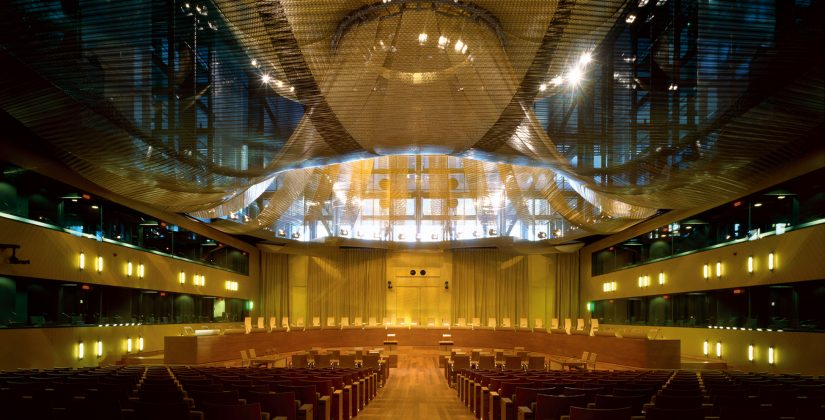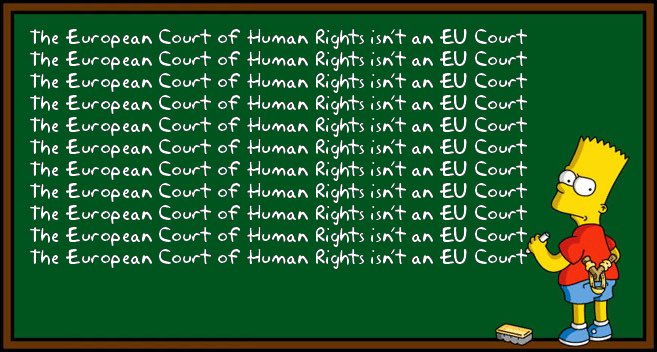The ECJ and the ECtHR: an updated idiot’s guide
In this guest post by Frank Cranmer, reposted from the Law & Religion UK blog, we are reminded of the key differences between the two separate but oft-confused pan-European legal regimes. … Continue reading

The grand chamber of the European Court of Justice in Luxembourg
Introduction
At 23:00 GMT on 31 January 2020, the UK departed from the European Union. Following that departure, there was a transition period which ended at 23:00 GM on 31 December 2020. Nevertheless, there are still people (mostly, dare one say it, politicians who really should know better) who manage to confuse our membership of the Council of Europe (“CoE”) with our (non)-membership of the European Union (“EU”) and, in particular, the European Court of Human Rights with the Court of Justice of the European Union. What follows is an attempt to dispel at least some of that confusion.
The EU and the CoE both have ministerial councils, permanent secretariats of officials, courts to determine disputes and assemblies of parliamentarians – but their functions, organisations and legal foundations are very different and you must not confuse the two. (There also are other less well-known Europe-wide political institutions, such as the Organization for Security and Co-operation in Europe, but they are much less important terms of domestic law.)
The Council of Europe
The Council of Europe, based in Strasbourg, was established on 5 May 1949 by ten countries, one of which was the United Kingdom, under the Treaty of London, which was ratified and entered into force on 3 September 1953. The CoE now has 46 member states, ranging in size from Ukraine to San Marino and covers virtually the whole of the European continent: the exceptions are Belarus, the Vatican – and the Russian Federation, following the decision of the Committee of Ministers on 16 March 2022 to expel it. It seeks to develop common and democratic principles throughout Europe based primarily on the Convention for the Protection of Human Rights and Fundamental Freedoms (commonly known as the European Convention on Human Rights or ECHR), for which it carries particular responsibility and to which all member states are parties.
The CoE has a multiplicity of institutions:
- The Committee of Ministers, with a six-month rotating chairmanship;
- A permanent secretariat, headed by the Secretary General and the Deputy Secretary General;
- The Parliamentary Assembly: a purely deliberative body that is not directly elected but composed of delegates from the national legislatures of the member states;
- A consultative, bicameral Congress of Local and Regional Authorities;
- A consultative Conference of International Non-Governmental Organisations; and
- The European Court of Human Rights (“ECtHR”).
In addition, the Council of Europe maintains a permanent advisory expert group on constitutional matters for which there is no parallel among the institutions of the EU: the European Commission for Democracy through Law, otherwise known as the Venice Commission, conducts studies and gives expert opinions on specific issues, very occasionally ranging far beyond the confines of the Council of Europe: see, for example, its Opinion on the electoral legislation of Mexico.
The European Union
What is now the European Union developed in stages from the original European Coal and Steel Community, established in 1951 with the principal intention of creating economic ties between France and West Germany in order to make future conflict less likely. The EU developed through agreements defined in a number of treaties relating to the member states within the EU and its method of operation. Today, the principal treaties are the Treaty on European Union (“TEU”) and the Treaty on the Functioning of the European Union (“TFEU”). The UK joined in 1972 and, as noted above, departed in 2020.
The EU operates through several distinct institutions, the most important of which, for our purposes, are as follows:
- The European Council is composed of the heads of government of the member states, its permanent President, Charles Michel, and the President of the European Commission. The permanent High Representative for Foreign Affairs and Security Policy, Federica Mogherini, also takes part in its meetings.
Which is not to be confused with…
- The Council of the European Union (sometimes just called “the Council” and sometimes still referred to as “the Council of Ministers”) consists of ministers of the member states with varying membership depending on the matters under discussion.
In addition:
- The European Commission, based in Brussels, operates at a supranational level and has three major functions (Article 17 TEU):
- to initiate Community action by making legislative proposals;
- to police and enforce EU legislation; and
- to act as the executive of the Community.
- The European Parliament, directly elected by the people of the member states, holds plenary sessions in both Strasbourg and Brussels and committee meetings in Brussels. The majority of decisions are now made by what used to be termed “co-decision” and is now called the ”ordinary legislative procedure”.
- The European Economic and Social Committee (“ECOSOC”) is a consultative body representative of employers, workers and other interest groups.
- The Court of Justice of the European Union (“ECJ” or “CJEU”) is based in Luxembourg and adjudicates disputes arising under EU law.
For the EU, human rights generally are enumerated in the Charter of Fundamental Rights of the European Union of December 2000, which came into full effect with the entry into force of the Treaty of Lisbon on 1 December 2009; however, Article 6 of the consolidated text of the Treaty on European Union (TEU) declares that
“Fundamental rights, as guaranteed by the European Convention for the Protection of Human Rights and Fundamental Freedoms and as they result from the constitutional traditions common to the Member States, shall constitute general principles of the Union’s law”.
So from an EU perspective, the EU Charter of Fundamental Rights and the ECHR are intertwined.
The two courts: the ECtHR
The European Court of Human Rights in Strasbourg was established under the Convention of 1950 to monitor respect for human rights by states parties. Complaints of human rights violations can be brought before the ECtHR by other states, by other parties or by individuals. (Previously, there was also a European Commission of Human Rights, elected by the Committee of Ministers, that acted as a filter mechanism for cases by deciding whether or not a petition to the Court was admissible: it was abolished when the ECtHR was restructured in 1998.)
The ECtHR consists of a judge from each member state. When a vacancy occurs, the government of the state concerned nominates three candidates for the empty seat; but it is the Parliamentary Assembly that fills the vacancy by electing one of the three nominated candidates. (Presumably, the reason why the British press have been known to describe the members of the Court as “unelected judges” is because your average journo has never bothered to read Article 39 ECHR.)
The Court normally sits in Chambers of seven judges; but if a sectional Chamber feels that a particular case referred to it raises a serious question affecting the interpretation of the Convention or if there is a risk of inconsistency with a previous judgment of the Court, it may relinquish jurisdiction to the Grand Chamber (GC) of 17 judges, consisting of the Court’s President and Vice-Presidents, the Section Presidents and the national judge from the state in question (if not otherwise eligible), together with other judges selected by lot to bring up the number to 17.
After a Chamber judgment has been delivered, the parties may request a referral of the case to the Grand Chamber. Such requests are accepted only exceptionally: a panel of judges of the Grand Chamber decides whether or not the case should be referred to the Grand Chamber itself for fresh consideration.
At the end of the hearing, the judges give their judgments: while one member of the Court will probably give the lead judgment for the majority, concurring and dissenting judgments are also delivered and recorded, in the same style as judgments in the courts of the UK and Ireland.

The two courts: the ECJ
The primary functions of the Court of Justice of the European Union (ECJ or CJEU) are to interpret EU law to ensure consistency across all EU countries and to settle disputes between member states and EU institutions – often as a result of “infringement proceedings” brought by the Commission against a member state. Individuals, companies or organisations can also bring cases before the Court if they believe that their rights have been infringed by an EU institution. In addition, a national court may interrupt a case and refer a point of EU law to the ECJ for an opinion.
As well as the ECJ itself, there is also a General Court (EGC), which used to be known as the Court of First Instance (CFI), with its own judges, to hear cases brought by private individuals, companies and some organisations and cases relating to competition law.
Each member state nominates one judge to the ECJ and one judge to the General Court. In addition, there are eight Advocates-General: the AG for a particular case presents an opinion to the Court in advance of its deliberations as a kind of amicus curiae. (The ECtHR does not have Advocates-General.)
The Court may sit either as a Grand Chamber of 15 judges (including the President and Vice-President) or in chambers of three or five judges, though Grand Chamber (GC) sittings are rare. At the end of the hearing, the Court pronounces a single judgment: dissents are not recorded.
So from a UK perspective, does the ECJ still matter?
Perhaps surprisingly, the answer is yes – at least for the near future. The UK still has a relationship with the EU as a result of the Northern Ireland Protocol and is bound by the terms of the Withdrawal Agreement.
Under the Withdrawal Agreement, the ECJ would no longer have general jurisdiction over the UK in relation to any acts that took place on or after 1 January 2021, which has now passed; however, the Political Declaration agreed by the UK and the EU in 2018 made clear that insofar as their “future relationship” contained concepts of EU law, disputes about them would have to be referred to the ECJ: see especially paras 83 and 134.
In June 2022, the European Commission launched infringement proceedings against the UK for not complying with significant parts of the Northern Ireland Protocol – proceedings which were overtaken by the conclusion of the Windsor Framework in February 2023. The price from the UK side was the scrapping of the Northern Ireland Protocol Bill: it still appears on the Parliamentary website, but the Government said when the Windsor Framework was concluded that it would not proceed further with it.
In a Commons Library Research Briefing, Brexit next steps: The Court of Justice of the EU and the UK published in February 2020, Sylvia de Mars sums up the position like this:
“Article 86(1) of the Withdrawal Agreement makes it clear that any cases pending before the CJEU at the end of the transition period will fall within the CJEU’s jurisdiction until they are finalised. This includes decisions on appeals.
Article 87 of the Withdrawal Agreement adds to this more specifically. It states that the European Commission has four years from the end of the transition period to bring infringement proceedings against the UK for breaches of EU law that took place during the transition period.
Any judgment handed down by the CJEU that is covered by these provisions will remain binding on the UK. As such, it is possible that a proceeding commenced by the European Commission in 2024 about a UK action (or failure to act) in 2020 will be decided by the CJEU in 2025, and will be binding on the UK” [emphasis added].
So the Court hasn’t become irrelevant to the UK quite yet.
Frank Cranmer